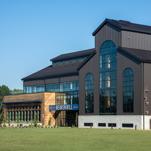Road Music Chapter One: Rosine, Kentucky

For this series, we’ll be following Paste’s own Curmudgeon, Geoffrey Himes, as he sets out on a massive road trip across the South, exploring musical landmarks, traditions and history along the way. First stop: Rosine, Ky.
Bluegrass is usually associated with southern Appalachia, the mountains between West Virginia and Georgia, where so many of its major figures lived. But the music was created and given its name a good distance from those mountains, in western Kentucky where the dark green grass does seem to have a blue tint when the sunlight hits it a certain way. That’s where Bill Monroe was born and raised.
That’s where young William, the youngest of eight children, learned Anglo-Celtic fiddle tunes from his Uncle Pendiver, who raised Bill after his parents died, and blues from Arnold Schultz, the African-American railroad worker who was passing through town. Eventually Bill would quit the old-time country duo with his older brother Charlie and fuse those fiddle tunes and blues into a revolutionary music that brought high-speed virtuosity to the old string-band instruments.
-

-

-

-

-

-

-

-

-

-

-

-

-

-

-

-

-

-

-

-

-

-

-

-

-

-

-

-

-

-

-

-

-

-

-

-

-

-

-

-













































